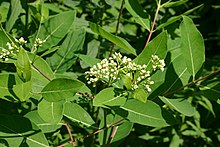Apocynum cannabinum
| Apocynum cannabinum | |
|---|---|

| |
| Apocynum cannabinum in flower | |
| Scientific classification | |
| Kingdom: | |
| Division: | |
| Class: | |
| Order: | |
| Family: | |
| Genus: | |
| Species: | A. cannabinum
|
| Binomial name | |
| Apocynum cannabinum | |
| Synonyms[1] | |
|
List
| |
Apocynum cannabinum (Dogbane, Amy Root, Hemp Dogbane, Prairie Dogbane, Indian Hemp, Rheumatism Root, or Wild Cotton)[2] is a perennial herbaceous plant that grows throughout much of North America - in the southern half of Canada and throughout the United States.[1][3] It is a poisonous plant: Apocynum means "poisonous to dogs". All parts of the plant are poisonous and can cause cardiac arrest if ingested. The cannabinum in the scientific name and the common names Hemp Dogbane and Indian Hemp refer to its similarity to Cannabis as a fiber plant (see Hemp), rather than as a source of a psychoactive drug (see Cannabis (drug))
Although dogbane is poisonous to livestock, it likely got its name from its resemblance to a European species of the same name.[4]
Distribution and habitat
Apocynum cannabinum grows in open wooded areas, ditches, and hillsides, and prefers moist places.
Description
Apocynum cannabinum grows up to 2 meters/6 feet tall. The stems are reddish and contain a milky latex capable of causing skin blisters. The leaves are opposite, simple broad lanceolate, 7–15 cm long and 3–5 cm broad, entire, and smooth on top with white hairs on the underside. The flowers are produced in mid summer, with large sepals, and a five-lobed white corolla.
Invasive species
In gardens it can be invasive, growing from spreading roots. When growing among corn, Apocynum cannabinum can reduce yields by up to 10% and when growing among soybeans, by up to 40%. It can be controlled through mechanical means, although it is difficult to control with herbicides.
Uses
In the fall, when toxins drain to the roots, the plant can be harvested for fiber, which can be used to make strong string and cordage for use in bows, fire-bows, nets and tie-downs.
Phytoremediation
Apocynum cannabinum is a phytoremediation plant, a hyperaccumulator used to sequester lead in its biomass.
Fiber
Apocynum cannabinum was used as a source of fiber by Native Americans,[5] to make hunting nets, fishing lines, clothing, and twine.[4] It is called qéemu [qǽːmu] in Nez Perce and [taxʷɨ́s] in Sahaptin. The Concow tribe call the plant pö (Konkow language).[6]
Medicinal
It is also used in herbal medicine to treat syphilis, rheumatism, intestinal worms, fever, asthma, and dysentery. Although the toxins from the plant can cause nausea and catharsis, it has also been used for slowing the pulse, and it is also a sedative and mild hypnotic.
See also
References
- ^ a b "The Plant List: A Working List of All Plant Species". Retrieved June 18, 2014.
- ^ Apocynum cannabinum, ITIS report
- ^ Biota of North America Program 2013 county distribution map
- ^ a b Heiser, C. B. (2003). Weeds in my Garden: Observations on some Misunderstood Plants. Portland, OR: Timber Press. p. 50. ISBN 0-88192-562-4.
- ^ Coville, F. V. (1897). "Notes On The Plants Used By The Klamath Indians Of Oregon" (pdf). Contributions from the U.S. National Herbarium. 5 (2): 87–108 (p. 103).
- ^ Chesnut, V. K. (1902). "Plants used by the Indians of Mendocino County, California". Contributions from the U.S. National Herbarium. 7 (3): 295–408 (p. 407). LCCN 08010527.
- Blanchan, Neltje (2002). Wild Flowers: An Aid to Knowledge of our Wild Flowers and their Insect Visitors. Project Gutenberg Literary Archive Foundation.
- A. Davis, K. Renner, C. Sprague, L. Dyer, D. Mutch (2005). Integrated Weed Management. MSU.
